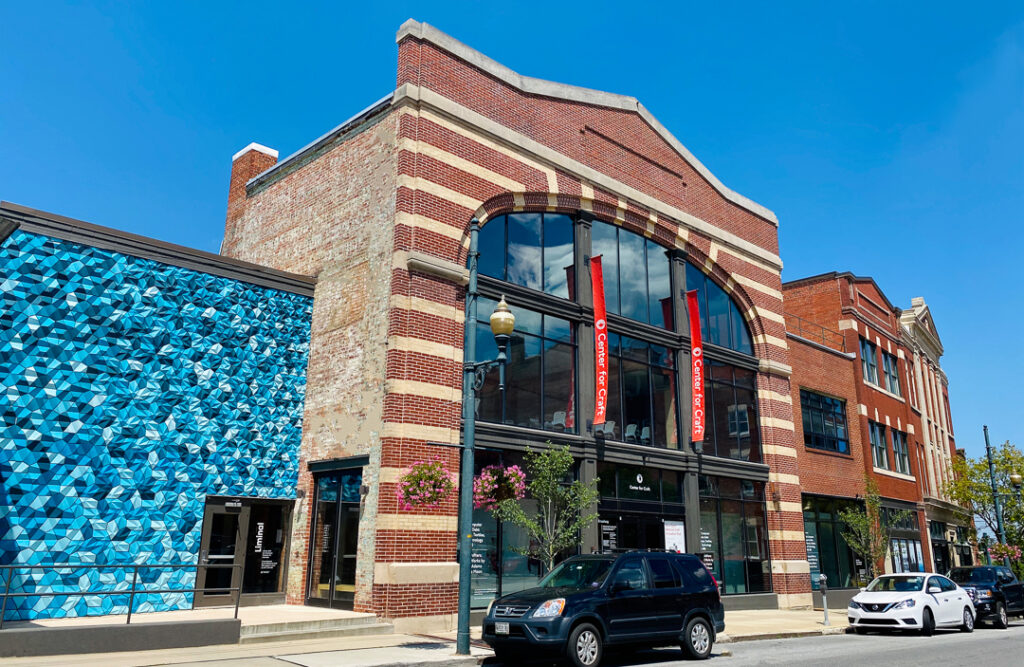Stephanie Moore tells how the Center for Craft rebuilt itself after losing its base in a university ten years ago.
(A message to the reader.)
When I discovered the Center for Craft, I was interviewing for the Executive Director position during my 18th year as Director and Curator of Visual Arts at VSA arts, an affiliate of the John F. Kennedy Center for the Performing Arts. The Center was tucked back on a remote 55 acres owned by the state of North Carolina about an hour south of its current location—with a small but mighty staff team of two and a half, and beholden to the University of which it was part. At the time, the ambition of the Center was to be an academic public service center that might defend craft as a scholarly course of study. Yet, what struck me about the leadership and staff was the camaraderie of the individuals who joined together for its cause. The board included both makers and scholars who came together in a room for soup each month to share updates on their respective studios and campuses, and consider the future.
The organization also brought together thought leadership from across the country in the form of a Craft Think Tank, established in 2002 to define and resource the needs required to turn craft into a legitimate field. They invested in shared physical space – the in-person kind, not on a screen or video. The organization held the conviction that knowledge was gained in-person to spur learning and collaboration, and to appreciate the conversations that happen when involving voices from within and outside customary boundaries. The topic of craft was pulling these voices together in a way that allowed for unfettered discourse and deeper conversation. I suspect their collective and committed efforts were as much about the objects and the recognition of their histories as the people and stories that bring craft to life.
For nearly 30 years, the Center for Craft has provided connections, broadened horizons, and shaped understandings about craft in the United States. These Craft Think Tanks resulted in projects that made significant headway towards placing craft within a larger cultural landscape including groundbreaking contributions such as Makers: A History of American Studio Craft, the first textbook to document ten decades of extraordinary accomplishments of the country’s craft artists. The Center also carved out a niche to instigate and bolster research for “modern craft studies” through the Craft Research Fund, which has become our longest-running grant program. We were the first to legitimize the study and practice of craft by providing these resources to foster scholarship, curatorial practice, exhibitions, and conferences.
Notable scholar Glenn Adamson shared in 2014, “When the Center was founded in the mid-1990s, craft had a reputation as more of a second-class cousin of art and design. Craft-oriented scholarship had only a limited presence in American universities, and exhibitions were all too often celebratory (and perhaps defensive) in tone, with little historical or theoretical critical apparatus.” At present, the Center for Craft is at the vanguard of the craft movement, advancing the understanding, prominence, and historical significance of craft and identifying and cultivating the next great researchers and artists.
Five months after I arrived in 2010, UNC Asheville abandoned the ambition to relocate the Center just 30 minutes north as part of a craft campus, where the staff would have been well-suited to work with faculty and students. Then, in 2013, the University cut the Center for Craft’s budget due to the economic downturn. Staff had two months to pack up, move out, and rebuild the Center for Craft as an independent entity. Despite the turmoil, we had the wherewithal to request that the intellectual property for the first 16 years of the organization’s history be transferred to a supporting nonprofit that might carry on its ambitions. Where we struggled to carve out a permanent home for ourselves within the university system, we were intent on thriving outside of it.
Untethered, we began to dream bigger and with more conviction about the importance of craft and our place as an independent nonprofit. The disruption, while wildly challenging, made us agile and adaptive, unafraid to be unconventional. As we all know, today’s challenges require us to remain flexible and swiftly adjust. Craft became a tool to help us dream, establish new ways, and break ground. With such a significant mission to advance the understanding of craft in the United States, the Center needed a home, not just to operate from but as a beacon of encouragement for future scholars and artists to understand, participate, and appreciate craft. In short, we needed to define our own legacy and a place to make it possible.
Recognizing that Western North Carolina and the surrounding area is a bastion for craft, in 2013 the Center purchased a building in downtown Asheville, North Carolina, to serve as a landmark and to preserve, honor, and advance craft’s legacy in the Southeast and beyond. Visitors and residents have long appreciated Asheville’s vibrant craft community and that craft has, for a long time, been a substantial driver of cultural tourism, economic empowerment, and prosperity. We explored and operated in the building for three years and from 2017 to 2019, with a handful of generous donors, visionary board volunteers, and dedicated staff, we raised $11MM through our Building a Future for Craft campaign. These funds were used to renovate the building, endow our longstanding grant programs, and fortify future programs. We successfully transitioned into our current, wholly owned facility and re-opened our doors just four months shy of the onset of the pandemic in 2020.
In 2021, the Center held our first online Craft Think Tank, given the isolation and need for care. The program advisors first acknowledged the tendency for craft conversations to take place in an echo chamber and voiced a strong desire to consider the adjacent directions in which craft was moving. We decided to bring together individuals who would cross domains, bringing different perspectives and knowledge of diverse areas of expertise both inside and outside craft. The program culminated in conversations about the many potential roles for craft in our families, neighborhoods, schools, community centers, and more. The discussion also centered voices and perspectives historically excluded from these conversations, focusing on questions about how the field might move toward embracing nuance and wholeness as we look toward the future.
Despite hesitations or reservations about moving the Craft Think Tank to a virtual format, we learned valuable lessons and expanded our capacities. With this guidance to inform the work ahead, in November 2022 the Center for Craft passed a new strategic framework that captures our aspirations through 2027 and beyond. Titled Craft Matters, the focus of the plan builds upon our strong foundation and foregrounds the “how and why” behind craft as a way to respond to the present challenges of social isolation, wellness, and inclusivity. The framework calls for a realignment of resources that approach the idea of scholarship more comprehensively and recognize the many paths into craft for the benefit of future generations.
The wonder of the Center’s Craft Think Tank—and my first impressions of the organization’s ethos—resides in its collaborative effort to imagine the future of craft, a vision in which craft flourishes at the heart of everyday life in ways that connect people, inspire making, and create community. In a world where more and more organizations are moving to virtual work, I question how shared physical space differs from virtual space when advocating for the handmade. The processes central to making are also about crafting community and exchanging perspectives. Does the next generation need to share physical space to feel connected and belong? Craft is not just about objects; but about who and how we want to be in the worlds we share. What I do know is that craft represents purposeful human activities full of processes and ideas through which material objects are produced, exchanged, and used. Cultural connection arises from such activities: this is the source of their meaningfulness.
As a public 501c3 charity established in the United States, the Center for Craft is held accountable to a public support test. This test is a provision of the IRS tax code that requires a third of a nonprofit organization’s support to come from the public in order to maintain a tax-exempt status and eligibility for grants. To encourage others to join our cause, we have created an entry-level membership program to allow individuals to demonstrate their critical support. If the Center has impacted your work in meaningful ways, or if our vision and accomplishments resonate with you, please sign up to show your encouragement and care. Harkening back to our first in-person Craft Think Tank while recognizing that we may reach farther and wider in the virtual realm, we need your support. Now as always, we believe that craft has the power to celebrate our differences while illuminating our similarities—igniting genuine human connection.
About Stephanie Moore
 Stephanie Moore currently serves as Executive Director for the Center for Craft. Over the past 14 years, Moore led the Center’s relocation to downtown Asheville, strengthened programs, and launched the Craft Matters 2023-2027 strategic framework. Moore holds a BA in both Art History and Studio Art from James Madison University and an MA in Nonprofit Management with a focus on material studies and the art of underrepresented cultures, from George Washington University.
Stephanie Moore currently serves as Executive Director for the Center for Craft. Over the past 14 years, Moore led the Center’s relocation to downtown Asheville, strengthened programs, and launched the Craft Matters 2023-2027 strategic framework. Moore holds a BA in both Art History and Studio Art from James Madison University and an MA in Nonprofit Management with a focus on material studies and the art of underrepresented cultures, from George Washington University.
gd2md-html: xyzzy Mon Aug 12 2024




